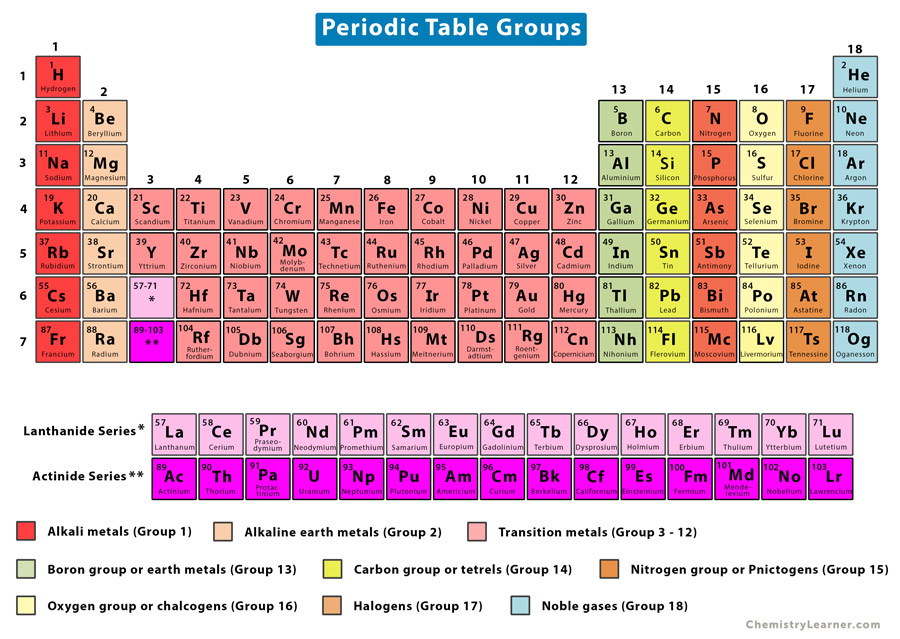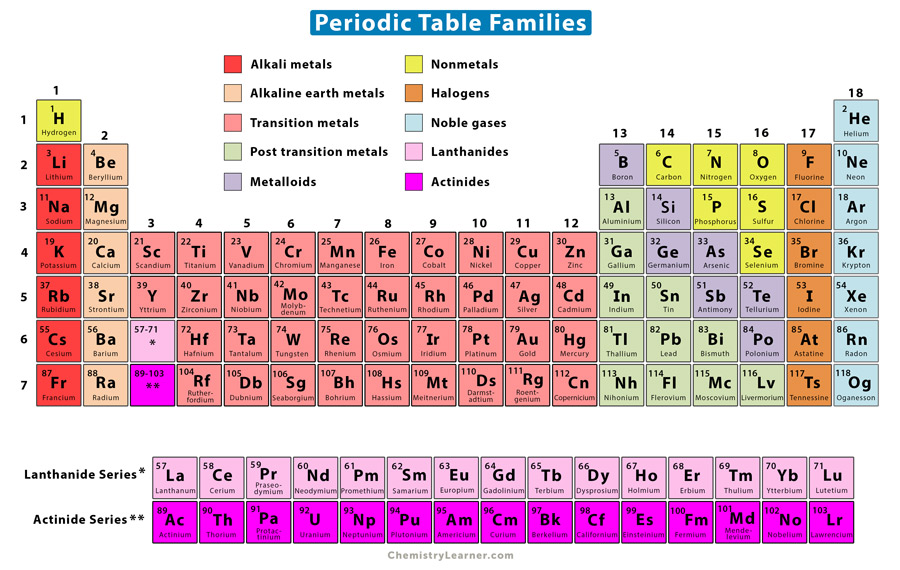Periodic Table Groups
Russian chemist Dimitry Mendeleev developed the periodic table in 1869 after finding that an element’s chemical properties depended on its atomic mass. He realized that certain properties were repeated when the elements were arranged according to their atomic masses. This discovery enabled Mendeleev to fill the gaps in the periodic table and place any missing elements correctly [1-7].
How is the Periodic Table Organized
The periodic table is organized into periods and groups.
Periods
Periods are horizontal rows of the periodic table. They represent elements having the same number of electron shells or energy levels. However, each element has one more proton than its preceding element. Thus, the periods are arranged according to the increasing atomic number of the elements.
There are seven periods, with the period number ranging from 1 to 7. In the first period, there are two elements, each having only one electron shell. As we go down the period, the number of electron shells increases [1-7].
Groups
The vertical columns of the periodic table are called groups. According to the IUPAC system of naming groups, there are 18 groups, with the group number ranging from 1 to 18. The elements in each group have the same number of valence electrons and hence, have similar chemical properties determined by the outermost electrons. These electrons are either donated by, accepted from, or shared with other elements during chemical bonding. Below are the different groups of the periodic table [1-7].
| Group Number | Group Name | Number of Valence Electrons | Examples |
|---|---|---|---|
| 1 | Alkali metals | 1 | Sodium (Na) and Potassium (K) |
| 2 | Alkaline earth metals | 2 | Calcium (Ca) and Magnesium (Mg) |
| 3 – 12 | Transition metals | d and f block metals have two valence electrons | Copper (Cu) and Zinc (Zn) |
| 13 | Boron group or earth metals | 3 | Boron (B) and Aluminum (Al) |
| 14 | Carbon group or tetrels | 4 | Carbon (C) and Silicon (Si) |
| 15 | Nitrogen group or Pnictogens | 5 | Nitrogen (N) and Phosphorus (P) |
| 16 | Oxygen group or chalcogens | 6 | Oxygen (O) and Sulfur (S) |
| 17 | Halogens | 7 | Chlorine (Cl) and Iodine (I) |
| 18 | Nobel gases | 8 | Helium (He) and Neon (Ne) |
Periodic Table Families
A family consists of elements having similar characteristics. The elements of a family may belong to the same group or spread across several groups. Each family of elements is color coded to understand their position in the periodic table. There are ten families. They are discussed below [1-7].
1. Alkali Metals
The alkali metals are all elements of Group I except hydrogen. These elements have one valence electron. They are highly reactive and can burst into flames when exposed to air. This is why alkali metals combine with other elements in compounds. They react with water quickly and must be stored in oil. Francium is the most reactive alkali metal, located in the seventh row. The reactivity decreases up the group, making lithium the least reactive element. Physically, alkali metals are shiny and white with low melting and boiling points.
2. Alkaline Earth Metals
The alkaline earth metals are located in Group 2 of the periodic table, from beryllium (Be) to radium (Ra). They have two electrons in their outermost shell and are the second most reactive after alkali metals. They are a strong reducing agent, meaning they can donate electrons quickly. They are also good conductors of heat and electricity. Physically, they have low density, melting point, and boiling point.
3. Transition Metals
The transition metals lie from Group 3 to Group 12. They have more than one oxidation state, meaning they can have many oxidation numbers. They have low ionization energy and high conductivity. Aside, they have high melting and boiling points. They can be malleable and shiny.
4. Post-Transition Metals
The post-transition metals are located in between transition metals and the metalloids. They span from Groups 13 to 16. They have some characteristics of transition metals but are soft and conduct more poorly than transition metals. Their melting points are lower than transition metals.
5. Metalloids
The metalloids display properties in between metals and nonmetals. Only six such elements exist, of which three (B, Si, and Ge) are semiconductors. They lie between Groups 13 and 16. Metalloids are not as good conductors of electricity as metals, nor are they as ductile as metals. They are brittle and can break easily.
6. Nonmetals
Nonmetals are on the top right of metalloids, spanning Groups 13 and 16. They have high electronegativity and ionization energy and are poor conductors of heat and electricity. They exist as gases like oxygen or solids like carbon. Although it is in Group 1, hydrogen is considered a nonmetal.
7. Halogens
The halogens lie in Group 17. They are highly electronegative and reactive, requiring one electron to complete their outermost shell. Hence, they typically exhibit a -1 oxidation state. They form salts with metals.
8. Noble Gases
The elements in Group 18 are called noble gases. They have complete outermost shells, resulting in stable electron configurations. Hence, they are the least reactive group on the periodic table, giving them nomenclature inert gases. They have low melting and boiling points and are colorless and odorless.
9. Lanthanides
Lanthanides are a part of the sixth row and lie within Group 3 of the periodic table. The name lanthanide comes from the first element of that row – lanthanum. They are a family of rare earth metals with one valence electron in the 5d shell. They are highly reactive and behave like strong reducing agents in chemical reactions. Aside, they are soft silvery-bright metals with high melting and boiling points.
10. Actinides
Actinides are located in the seventh row and within Group 3. Their name comes from actinium, the first element of that row. They are another family of rare earth metals that are highly reactive. They also have high electropositivity and are radioactive. Aside, these elements are allotropic, paramagnetic, and pyromorphic. Physically, they are very similar to lanthanides – soft, silvery, malleable, and ductile.
For the interest of space, the lanthanides and actinides are shown below the periodic table.

